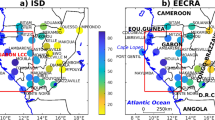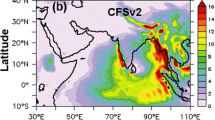Abstract
We investigate the influence of clouds on the surface energy budget and surface temperature in the sea-ice covered parts of the ocean north of the Arctic circle in present-day climate in nine global climate models participating in the Coupled Model Intercomparison Project phase 3, CMIP3. Monthly mean simulated surface skin temperature, radiative fluxes and cloud parameters are evaluated using retrievals from the extended AVHHR Polar Pathfinder (APP-x) product. We analyzed the annual cycle but the main focus is on the winter, in which large parts of the region experience polar night. We find a smaller across-model spread as well as better agreement with observations during summer than during winter in the simulated climatological annual cycles of total cloudiness and surface skin temperature. The across-model spread in liquid and ice water paths is substantial during the whole year. These results qualitatively agree with earlier studies on the present-day Arctic climate in GCMs. The climatological ensemble model mean annual cycle of surface cloud forcing shows good agreement with observations in summer. However, during winter the insulating effect of clouds tends to be underestimated in models. During winter, most of the models as well as the observations show higher monthly mean total cloud fractions, associated with larger positive surface cloud forcing. Most models also show good correlation between the surface cloud forcing and the vertically integrated ice and liquid cloud condensate. The wintertime ensemble model mean total cloud fraction (69%) shows excellent agreement with observations. The across-model spread in the winter mean cloudiness is substantial (36–94%) however and several models significantly underestimate the cloud liquid water content. If the two models not showing any relationship between cloudiness and surface cloud forcing are disregarded, a tentative across-model relation exists, in such a way that models that simulate large winter mean cloudiness also show larger surface cloud forcing. Even though the across-model spread in wintertime surface cloud forcing is large, no clear relation to the surface temperature is found. This indicates that other processes, not explicitly cloud related, are important for the simulated across-model spread in surface temperature.









Similar content being viewed by others
References
ACIA (2005) Impacts of a warming Arctic. Arctic Climate Impact Assessment (ACIA). Tech. rep., Cambridge University Press, Cambridge, pp 140
Ackerman TP, Stokes GM (2003) The atmospheric radiation measurement program. Phys Today 56(1): 010. doi:10.1063/1.1554135
Arzel O, Fichefet T, Goosse H (2006) Sea ice evolution over the 20th and 21st centuries as simulated by current AOGCMs. Ocean Model 12:401–415
Cavalieri D, Parkinson C, Gloersen P, Zwally HJ (1996) Sea ice concentrations from Nimbus-7 SMMR and DMSP SSM/I passive microwave data [1982–1999]. Technical report, National Snow and Ice Data Center, Boulder, Colorado USA. Digital media. http://nsidc.org/data/nsidc-0051.html (updated 2006)
Chapman WL, Walsh JE (2007) Simulations of Arctic temperature and pressure by global coupled models. J Clim 20:609. doi:10.1175/JCLI4026.1
Curry JA et al (2000) FIRE Arctic clouds experiment. Bull Am Meteor Soc 81:5–30
Drobot SD, Maslanik JA, Fowler C (2003) Atmospheric and sea ice conditions during the SHEBA year: historical and spatial assessment. Polar Geogr 27:15–37
Eisenman I, Untersteiner N, Wettlaufer JS (2007) On the reliability of simulated Arctic sea ice in global climate models. Geophys Res Lett 34:10 501. doi:10.1029/2007GL029914
Gorodetskaya V, Tremblay LB, Liepert B, Cane MA, Cullather RI (2008) Simulations of Arctic temperature and pressure by global coupled models. J. Clim 21:866. doi:10.1175/2007JCLI1614.1
Intrieri JM, Fairall CW, Shupe MD, Persson POG, Andreas EL, Guest PS, Moritz RE (2002) An annual cycle of Arctic surface cloud forcing at SHEBA. J Geophys Res (Oceans) 107:8039. doi:10.1029/2000JC000439
Intrieri JM, Shupe MD, Uttal T, McCarty BJ (2002) An annual cycle of Arctic cloud characteristics observed by radar and lidar at SHEBA. J Geophys Res 107(C10):8030. doi:10.1029/2000JC000423
Kållberg P, Berrisford P, Hoskins B, Simmmons A, Uppala S, Lamy-Thépaut S, Hine R (2005): ERA-40 atlas. Tech. rep., ERA-40 Project Report Series no 19, The European Centre for Medium-Range Weather Forecasts
Key J (2002) The cloud and surface parameter retrieval (CASPR) System for Polar AVHRR User’s Guide. Tech. rep., Cooperative Institute for Meteorological Satellite Studies, University of Wisconsin, Wisconsin, 61 pp. http://stratus.ssec.wisc.edu/caspr/documentation.html
Liou K (1992) Radiation and cloud processes in the atmosphere: theory, observation, and modeling. Oxford University Press, New York, pp 487
Maslanik J, Fowler C, Key J, Scambos T, Hutchinson T, Emery W (1997) AVHRR-based Polar Pathfinder products for modeling applications. Ann Glaciol 25:388–392
Maslanik JA, Key J, Fowler CW, Nguyen T, Wang X (2001) Spatial and temporal variability of satellite-derived cloud and surface characteristics during FIRE-ACE. J. Geophys. Res 106:15233–15250. doi:10.1029/2000JD900284
Meehl GA, Covey C, Delworth T, Latif M, McAvaney B, Mitchell JFB, Stouffer RJ, Taylor KE (2007) The WCRP CMIP3 multimodel dataset: a new era in climate change research. Bull Am Meteor Soc 88:1383–1394. doi:10.1175/BAMS-88-9-1383
Persson POG, Fairall CW, Andreas EL, Guest PS, Perovich DK (2002) Measurements near the Atmospheric Surface Flux Group tower at SHEBA: Near-surface conditions and surface energy budget. J Geophys Res 107:8045. doi:10.1029/2000JC000705
Ramanathan V, Cess RD, Harrison EF, Minnis P, Barkstrom BR, Ahmad E, Hartmann D (1989) Cloud-radiative forcing and climate: results from the Earth radiation budget experiment. Science 243:57–63
Raschke E, Bauer P, Lutz HJ (1992) Remote sensing of clouds and surface radiation budget over polar regions. Int J Remote Sens 13(1):13–22
Schweiger AJ, Lindsay RW, Key JR, Francis JA (1999) Arctic clouds in multiyear satellite data sets. Geophys Res Lett 26:1845–1848. doi:10.1029/1999GL900479
Shupe M, Intrieri J (2004) Cloud radiative forcing of the Arctic surface: The influence of cloud properties, surface albedo, and solar zenith angle. J Clim 17:616–628
Shupe MD, Matrosov SY, Uttal T (2006) Arctic mixed-phase cloud properties derived from surface-based sensors at SHEBA. J Atmos Sci 63:697–711
Solomon S, Qin D, Manning M, Chen Z, Marquis M, Averyt K, Tignor M (eds) HM (2007) IPCC-AR4, IPCC: Climate Change 2007: The scientific basis. Contribution of Working Group I to the Fourth Assessment Report of the Intergovernmental Panel on Climate Change. Technical report, Cambridge University Press, Cambridge pp 996
Sorteberg A, Kattsov V, Walsh JE, Pavlova T (2007) The Arctic surface energy budget as simulated with the IPCC AR4 AOGCMs. Clim Dyn 29:131–156
Stephens GL et al (2002) The Cloudsat Mission and the A-Train. Bull. Am Meteorol Soc 83:1771–1790
Tao X, Walsh J, Chapman W (1996) An assessment of global climate model simulations of Arctic air temperatures. J Clim 9:1060–1076
Tjernström M, Sedlar J, Shupe MD (2008) How well do regional climate models reproduce radiation and clouds in the Arctic? An evaluation of ARCMIP simulations. J Appl Meteorol Clim 47:2405. doi:10.1175/2008JAMC1845.1
Uppala SM et al (2005) The ERA-40 re-analysis. Q J R Meteorol Soc 131:2961–3012
Uttal T, Frisch S, Wang X, Key J, Schweiger A, Sun-Mack S, Minnis P (2005) Comparison of monthly mean cloud fraction and cloud optical depth determined from surface cloud radar, TOVS, AVHRR, AND MODIS over Barrow, Alaska. AMS 8th conference on polar meteorology, San Diego
Uttal T, Matrosov SY, Snider JB, Kropfli RA (1994) Relationship between ice water path and downward longwave radiation for clouds optically thin in the infrared: observations and model calculations. J Appl Meteorol 33:348–357
Uttal T et al (2002) Surface heat budget of the Arctic Ocean. Bull Am Meteorol Soc 83:255–276
Vavrus S, Waliser D, Schweiger A, Francis J (2008) Simulations of 20th and 21st century Arctic cloud amount in the global climate models assessed in the IPCC AR4. Clim Dyn. doi:10.1007/s00382-008-0475-6
Walsh JE, Chapman WL (1998) Arctic cloud–radiation–temperature associations in observational data and atmospheric reanalyses. J Clim 11:3030–3045
Walsh JE, Kattsov VM, Chapman WL, Govorkova V, Pavlova T (2002) Comparison of Arctic climate simulations by uncoupled and coupled global models. J Clim 15:1429–1446
Wang X, Key J (2003) Recent trends in arctic surface, cloud, and radiation properties from space. Science 299:1725–1728
Wang X, Key J (2005a) Arctic surface, cloud, and radiation properties based on the AVHRR Polar Pathfinder data set. Part I: spatial and temporal characteristics. J Clim 18(14):2558–2574
Wang X, Key J (2005b) Arctic surface, cloud, and radiation properties based on the AVHRR Polar Pathfinder data set. Part II: recent trends. J Clim 18(14):2575–2593
Winker DM, Hunt WH, McGill MJ (2007) Initial performance assessment of CALIOP. Geophys. Res. Lett 34:19 803. doi:10.1029/2007GL030135
Winker DM, Pelon J, McCormick MP (2003) The CALIPSO mission: spaceborne lidar for observation of aerosols and clouds. Proc SPIE Int Soc Opt Eng 4893:1–11
Zuidema P, Joyce R (2008) Water vapor, cloud liquid water paths, and rain rates over northern high latitude open seas. J Geophys Res 113(D12): 5205. doi:10.1029/2007JD009040
Acknowledgments
We thank Andrew Gettelman for valuable comments on the manuscript. We acknowledge the modeling groups, the Program for Climate Model Diagnosis and Intercomparison (PCMDI) and the WCRP’s Working Group on Coupled Modelling (WGCM) for their roles in making available the WCRP CMIP3 multi-model dataset. Support of this dataset is provided by the Office of Science, US Department of Energy.
Author information
Authors and Affiliations
Corresponding author
Rights and permissions
About this article
Cite this article
Karlsson, J., Svensson, G. The simulation of Arctic clouds and their influence on the winter surface temperature in present-day climate in the CMIP3 multi-model dataset. Clim Dyn 36, 623–635 (2011). https://doi.org/10.1007/s00382-010-0758-6
Received:
Accepted:
Published:
Issue Date:
DOI: https://doi.org/10.1007/s00382-010-0758-6




